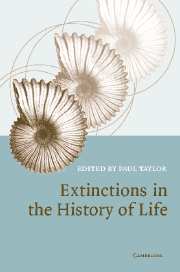Book contents
- Frontmatter
- Contents
- Notes on contributors
- Preface
- 1 Extinction and the fossil record
- 2 Extinctions in life's earliest history
- 3 Mass extinctions in plant evolution
- 4 The beginning of the Mesozoic: 70 million years of environmental stress and extinction
- 5 Causes of mass extinctions
- 6 The evolutionary role of mass extinctions: disaster, recovery and something in-between
- Glossary
- Index
- References
2 - Extinctions in life's earliest history
Published online by Cambridge University Press: 18 December 2009
- Frontmatter
- Contents
- Notes on contributors
- Preface
- 1 Extinction and the fossil record
- 2 Extinctions in life's earliest history
- 3 Mass extinctions in plant evolution
- 4 The beginning of the Mesozoic: 70 million years of environmental stress and extinction
- 5 Causes of mass extinctions
- 6 The evolutionary role of mass extinctions: disaster, recovery and something in-between
- Glossary
- Index
- References
Summary
GEOLOGICAL TIME
All of geological time – the total history of the Earth – is divided into two great Eons, the Precambrian and the Phanerozoic (Figure 2.1). The Precambrian Eon is the older and much the longer of the two, extending from when the planet formed, about 4500 million years (Ma: mega anna) ago, to the appearance of fossils of hard-shelled invertebrate animals such as trilobites and various kinds of shell-bearing molluscs at about 550 Ma ago. The eon is composed of two Eras, the older Archean Era (from the Greek archaios, ancient) that spans the time from 4500 to 2500 Ma ago; and the younger Proterozoic Era (the era of earlier life, from the Greek proteros, earlier, and zoe, life) that extends from 2500 Ma ago to the close of the Precambrian.
The younger and shorter eon is the Phanerozoic (the eon of evident life, from the Greek phaneros, evident or visible, and zoe). The Phanerozoic Eon encompasses the most recent roughly 550 Ma of Earth history and is divided into three eras (from oldest to youngest, the Palaeozoic, Mesozoic, and Cenozoic Eras; Figure 2.1), each subdivided into shorter segments known as geologic periods. The oldest such period of the Palaeozoic Era (and, consequently, of the Phanerozoic Eon), spanning the time from about 550 to roughly 500 Ma ago and named after Cambria, the Roman name for Wales where rocks of this age were first formally described, is known as the Cambrian Period.
- Type
- Chapter
- Information
- Extinctions in the History of Life , pp. 35 - 60Publisher: Cambridge University PressPrint publication year: 2004



